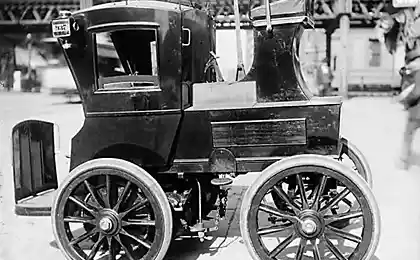1577
Call the new taxi
"It is a new taxi" - the so-called article, published in the June issue of Technology, Youth for 1966. Since then, it has been almost half a century, but the taxi VNIITE-Fri still meets most of the requirements for such machines. About the history of one of the most unusual and interesting domestic cars I will tell below ...
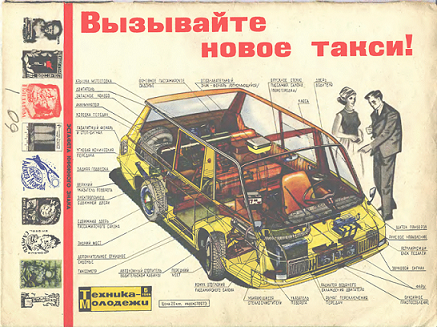
History of the Soviet taxi began in the early 20s, when the Moscow France bought a large batch of taxis Reno. Before the war there were taxis in all major cities, but rather mass transport taxi was only after the war. In the taxi companies began mass flow Wins. Machinery painted in two colors at the same time on the boards of the famous checkered taxi appeared. Alterations did not take long: instead studded leatherette fabric seat, put the taximeter and connected thereto Green Lantern in the upper right corner of the windshield. He burned, indicating a free car and quenched when the taximeter.

In the late 50's Victory gradually replaced GAZ-21. Volga were very hardy machines of domestic cars but they kept working hard in a taxi. Plant guaranteed run up to the first major overhaul of 200 thousand. Km, which other machines nursed for a year and a half. I had to create a network of specialized factories to repair a taxi from which light gray car back bright red roofs, for that taxi drivers called them "Little Red Riding Hood."

But were the Volga and disadvantages. The first machine required constant qualified maintenance chassis so shpritsevat almost twice a week. Seat, power windows, door locks constantly broke in taxi pools created special areas for repair. But most importantly, gasoline consumption was too great. Installed by the operating costs of 15 liters overlap even for experienced drivers. In general, it became clear that we need a dedicated taxi car.
Requirements to it formulated in the early 50s: the partition between the driver and passenger, the entrance to the car just right, placing the baggage in the cabin, so that the driver did not have to go out and help to load it in the trunk and the increased volume of the cabin. According to them, we have drafted a taxi car based on the Victory and handed it to GAS. However, the plant declined to release a prototype under the pretext of transition from Victory on the Volga.
However, after the decision of the USSR Council of Ministers (№ 81 dated 27 January 1962) had nowhere to go. To start GAZ tried to do a little blood, releasing in 1963, a prototype of the Volga M-21T, designed to work in a taxi. Plant tried to make a minimum modifications to the serial car.
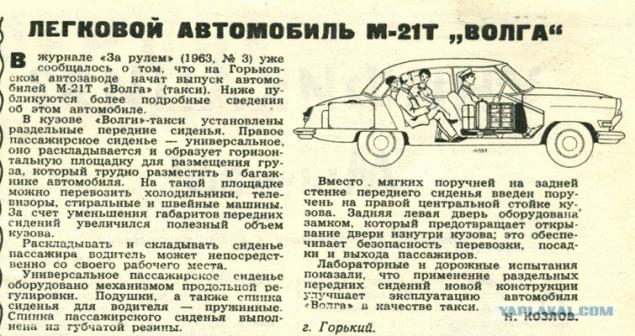
The car finally got a partition separating the driver from the passengers and several enlarged interior. On a folding front passenger seat could accommodate bulky items. Wherein the left rear door can be opened only from the outside.

To accommodate the partition driver's seat moved forward and back sofa (by reducing the backrest) ago, but interior was still a tight fit.

Given the shortcomings of the M-21T, experts recently created VNIITE (All-Union Scientific Research Institute of Technical Aesthetics) proposed to deploy a folding seat back forward, which slightly increases your seat and seal the rear door opening. Available now passengers remained enlarged right front door, which was later supposed to make sliding. However, GAS categorically rejected such improvements in the body of the Volga was required to make too many changes. It became clear that half-measures will not do.
Work on the creation of a taxi headed Yuri Aronovich Dolmatovsky, converted into VNIITE from us.
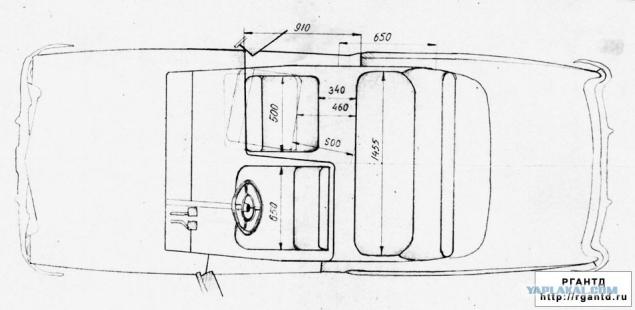
To start VNIITE experts have carefully analyzed the domestic and foreign experience in operating a taxi. In the early 60s the average daily vehicle miles traveled in Leningrad was about 190 km. In this work the driver is characterized by high strength. Even in the rare stream of cars of that time every 9 seconds he committed any act of driving. In cold weather, drivers suffer from drafts, because of the change of doors opened up to 150 times. In addition, although it was not said openly, every year growing number of attacks on taxi drivers for revenue.
Foreign experience did not give a clear answer to the question of what should be a taxi. As in the Soviet Union, most of the cars was a regular production cars with minor changes. However, in some countries the requirements for taxi regulated by law and in this case produced specialized machines, such as Chekker A8:

And Austin FX4:

They fully meet the requirements of a special taxi, but differed in large dimensions and weight. For these reasons, as a prototype for a new taxi they were not good.
For prospective taxi Yuri Dolmatovsky decided to use wagon-type: motor cross located behind the driver's seat and over the front axle. It is fully possible to use the length of the car for passengers and luggage:
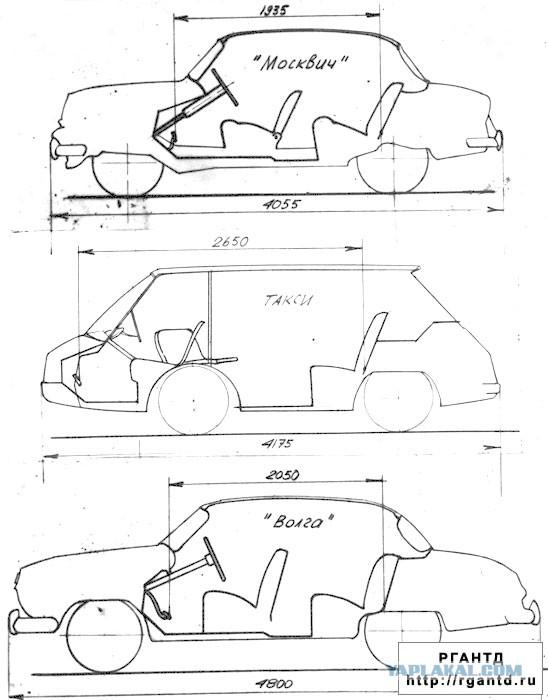
The car was a foot shorter than the Volga, and the interior can be transported refrigerator.

The appearance of the new machine was determined his appointment. Large windows provide excellent visibility, and the short wheelbase excellent maneuverability. Apparently, this sketch was created by the famous Soviet designer Eduard Molchanov.

On the basis of a taxi in budschem supposed to create a whole family of cars for different purposes: taxi with an elongated body, a delivery van and a car terrain.

Work on the detailed design of the new taxi was conducted in VNIITE. They are well shows how to create cars that are already far away from us, a non-digital analog era.
On systems of computer-aided design and solid modeling thought only science fiction writers, so to start preparing dozens of sketches depicting the car from different angles.
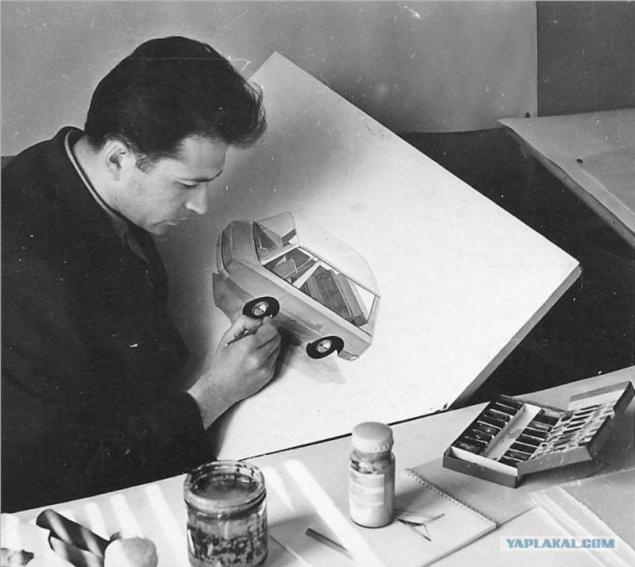
Was worked like appearance and interior

After that comes the turn of clay models to see the shape of the car entirely.

Finally appeared the final model, made strictly to scale. It necessarily considered from different angles in daylight. Model only allows us to understand how it will look real car.

After the approval of a scale model began detailed design and preparation of drawings. Because of the complex forms the outer surfaces of vehicles, many of them carried out in full size. Since then they shot patterns.

An important step was the so-called planting layouts. Wooden life-size mock-ups were made of the car body and designers to imagine checked what the future will have passengers.

Tested interior capacity:

Ease of entry and exit:

Particular attention was paid to the driver's seat:

If necessary, the layout has been amended.
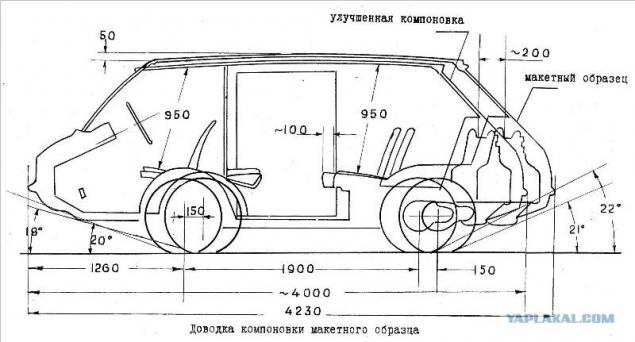
Finally produced a full-size layout. He was exactly the size and appearance of the car. It is also viewed from all sides in the daylight. Adoption layout gave the nod to prototyping.
How did was arranged VNIITE-Fri? The engine and gearbox have the serial Moskvich, but many components and assemblies designed and manufactured separately. By the design of the car was a lot of interesting novelties:

Supporting framework of steel profiles paneling made of fiberglass. This facilitated the small body repair. Replace the damaged panel could easily one person is not required straightening and coloring.

Not to pull long and unreliable traction through the salon for throttle and clutch hydraulic actuators used. Thus he was able to move the pedal back and forth to fit a growth driver. The seat was fixed. Sliding Door Motor Control, open and close it could only driver. Trying to ride for free now ended at the nearest police station.

The rear passenger seat slides back to 20 cm. In this case, a taxi easily climbed the fridge or stroller. Pay attention to the lights. They closed rotary flap with a number. Outside the city opened the headlights, but to clean the room

In general, the lack of space inside for four

An interesting feature is the blank under the door on the left side of the cab. Even the design of deemed export to countries with left-hand traffic.


History of the Soviet taxi began in the early 20s, when the Moscow France bought a large batch of taxis Reno. Before the war there were taxis in all major cities, but rather mass transport taxi was only after the war. In the taxi companies began mass flow Wins. Machinery painted in two colors at the same time on the boards of the famous checkered taxi appeared. Alterations did not take long: instead studded leatherette fabric seat, put the taximeter and connected thereto Green Lantern in the upper right corner of the windshield. He burned, indicating a free car and quenched when the taximeter.

In the late 50's Victory gradually replaced GAZ-21. Volga were very hardy machines of domestic cars but they kept working hard in a taxi. Plant guaranteed run up to the first major overhaul of 200 thousand. Km, which other machines nursed for a year and a half. I had to create a network of specialized factories to repair a taxi from which light gray car back bright red roofs, for that taxi drivers called them "Little Red Riding Hood."

But were the Volga and disadvantages. The first machine required constant qualified maintenance chassis so shpritsevat almost twice a week. Seat, power windows, door locks constantly broke in taxi pools created special areas for repair. But most importantly, gasoline consumption was too great. Installed by the operating costs of 15 liters overlap even for experienced drivers. In general, it became clear that we need a dedicated taxi car.
Requirements to it formulated in the early 50s: the partition between the driver and passenger, the entrance to the car just right, placing the baggage in the cabin, so that the driver did not have to go out and help to load it in the trunk and the increased volume of the cabin. According to them, we have drafted a taxi car based on the Victory and handed it to GAS. However, the plant declined to release a prototype under the pretext of transition from Victory on the Volga.
However, after the decision of the USSR Council of Ministers (№ 81 dated 27 January 1962) had nowhere to go. To start GAZ tried to do a little blood, releasing in 1963, a prototype of the Volga M-21T, designed to work in a taxi. Plant tried to make a minimum modifications to the serial car.

The car finally got a partition separating the driver from the passengers and several enlarged interior. On a folding front passenger seat could accommodate bulky items. Wherein the left rear door can be opened only from the outside.

To accommodate the partition driver's seat moved forward and back sofa (by reducing the backrest) ago, but interior was still a tight fit.

Given the shortcomings of the M-21T, experts recently created VNIITE (All-Union Scientific Research Institute of Technical Aesthetics) proposed to deploy a folding seat back forward, which slightly increases your seat and seal the rear door opening. Available now passengers remained enlarged right front door, which was later supposed to make sliding. However, GAS categorically rejected such improvements in the body of the Volga was required to make too many changes. It became clear that half-measures will not do.
Work on the creation of a taxi headed Yuri Aronovich Dolmatovsky, converted into VNIITE from us.

To start VNIITE experts have carefully analyzed the domestic and foreign experience in operating a taxi. In the early 60s the average daily vehicle miles traveled in Leningrad was about 190 km. In this work the driver is characterized by high strength. Even in the rare stream of cars of that time every 9 seconds he committed any act of driving. In cold weather, drivers suffer from drafts, because of the change of doors opened up to 150 times. In addition, although it was not said openly, every year growing number of attacks on taxi drivers for revenue.
Foreign experience did not give a clear answer to the question of what should be a taxi. As in the Soviet Union, most of the cars was a regular production cars with minor changes. However, in some countries the requirements for taxi regulated by law and in this case produced specialized machines, such as Chekker A8:

And Austin FX4:

They fully meet the requirements of a special taxi, but differed in large dimensions and weight. For these reasons, as a prototype for a new taxi they were not good.
For prospective taxi Yuri Dolmatovsky decided to use wagon-type: motor cross located behind the driver's seat and over the front axle. It is fully possible to use the length of the car for passengers and luggage:

The car was a foot shorter than the Volga, and the interior can be transported refrigerator.

The appearance of the new machine was determined his appointment. Large windows provide excellent visibility, and the short wheelbase excellent maneuverability. Apparently, this sketch was created by the famous Soviet designer Eduard Molchanov.

On the basis of a taxi in budschem supposed to create a whole family of cars for different purposes: taxi with an elongated body, a delivery van and a car terrain.

Work on the detailed design of the new taxi was conducted in VNIITE. They are well shows how to create cars that are already far away from us, a non-digital analog era.
On systems of computer-aided design and solid modeling thought only science fiction writers, so to start preparing dozens of sketches depicting the car from different angles.

Was worked like appearance and interior

After that comes the turn of clay models to see the shape of the car entirely.

Finally appeared the final model, made strictly to scale. It necessarily considered from different angles in daylight. Model only allows us to understand how it will look real car.

After the approval of a scale model began detailed design and preparation of drawings. Because of the complex forms the outer surfaces of vehicles, many of them carried out in full size. Since then they shot patterns.

An important step was the so-called planting layouts. Wooden life-size mock-ups were made of the car body and designers to imagine checked what the future will have passengers.

Tested interior capacity:

Ease of entry and exit:

Particular attention was paid to the driver's seat:

If necessary, the layout has been amended.

Finally produced a full-size layout. He was exactly the size and appearance of the car. It is also viewed from all sides in the daylight. Adoption layout gave the nod to prototyping.
How did was arranged VNIITE-Fri? The engine and gearbox have the serial Moskvich, but many components and assemblies designed and manufactured separately. By the design of the car was a lot of interesting novelties:

Supporting framework of steel profiles paneling made of fiberglass. This facilitated the small body repair. Replace the damaged panel could easily one person is not required straightening and coloring.

Not to pull long and unreliable traction through the salon for throttle and clutch hydraulic actuators used. Thus he was able to move the pedal back and forth to fit a growth driver. The seat was fixed. Sliding Door Motor Control, open and close it could only driver. Trying to ride for free now ended at the nearest police station.

The rear passenger seat slides back to 20 cm. In this case, a taxi easily climbed the fridge or stroller. Pay attention to the lights. They closed rotary flap with a number. Outside the city opened the headlights, but to clean the room

In general, the lack of space inside for four

An interesting feature is the blank under the door on the left side of the cab. Even the design of deemed export to countries with left-hand traffic.












